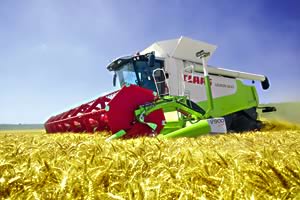 |
|||||||||
|
|||||||||||||||||||
Claas Set the Harvesting Technology Pace Faced with restrictions such as transport width and weight, the challenge for any designer and engineer is how greater output and capacity can be achieved from the same sized ‘box’.
To achieve and maintain high outputs, a modern agricultural machine, such as a combine harvester, therefore relies not only on mechanical systems to achieve output, but also sophisticated electronic driver aids. For many years CLAAS has led the way in developing new practical technology designed to both reduce the driver’s workload, but at the same time increase productivity, especially for combine harvesters. At this year’s Cereals Event, for each of the main machines on display, such as the LEXION 600, CLAAS UK will not only be focussing on the mechanical elements, but also both the integrated and optional electronic systems available to help the operator increase and maintain high output performance, and so achieve outputs as high as 100 tonnes/hour. Steering systems It is now 10 years since CLAAS introduced LASER PILOT, the first automatic steering system for combine harvesters that is still widely used by the vast majority of LEXION, and more recently TUCANO, operators. By enabling the operator to focus on the settings and overall performance of the combine, this not only had a major impact on overall performance but also helped reduce operator fatigue. Taking this a stage further, CLAAS now offer a complete range of GPS PILOT steering systems, from simple Egnos based guidance units, through to RTK and the unique BASELINE HD automatic steering system, that not only ensures that a full cutterbar is maintained, but that the field is cut in the most efficient manner, again helping to save time and money. Baseline HD is unique to CLAAS and uses a tripod-mounted base station to provide an accuracy of ±4-6cm, similar to RTK systems but far less expensive. Unlike other tripod systems, the Baseline HD unit also incorporates an in-built 36-hour battery, making it very compact. The system uses an FM signal, with a range of about 5Km, and does not rely on line-of-sight, so is more robust and does not get ‘lost’ as easily. Aside from combines, BASELINE HD can be used for one or more machines and is ideal for operations requiring greater accuracy, such as drilling. For tractors, CLAAS will also be highlighting the benefits of CAM PILOT, which has been developed by CLAAS as an alternative to GPS systems and uses digital imagery to enable the tractor to automatically follow straight or curved swaths or crop rows. CRUISE PILOT The first of its kind on the market, CRUISE PILOT was designed to enable the combine to automatically maintain forward speed and throughput far more quickly and efficiently than the operator. Using sensors in the front elevator and the engine, once the operator has set the level at which he wants the combine to work, CRUISE PILOT will monitor both throughput and engine load, and as the volume changes, so the combine’s forward speed is automatically adjusted to ensure that the set throughput is maintained. CEBIS Another CLAAS first at that time was the new QUANTIMETER grain monitoring system that is still in use today. Linked into CEBIS, aside from providing accurate crop specific yield data, the latest version also provides the operator with constant information on moisture content. TELEMATICS In addition to the benchmarking, machine location and live yield monitoring functions that TELEMATICS offer, one of the most useful features is the harvest efficiency analysis function. By being able to analyse all aspects of the harvesting process, including how, when and where the combine unloaded, this provides the information needed to refine the system and so increase productivity. For instance by using this information, in 2007 having studied the information provided from the 2006 harvest, by tightening up his trailer logistics and reducing idling time by 7%, one customer increased the actual harvesting time by 8% to where the combine was working for 81% of its time, making it the most efficient in the UK. It is fair to say that with the development of these many ‘firsts’, as a harvesting machinery specialist CLAAS has set the pace of high output, cost effective combine over the past 15 years, and looks set to continue this leading position well into the future.
|
|||||||||||||||||||

|
|||||||||||||||||||
| home | agri-services | pedigree
pen | news | dairy | beef | machinery property | organisations | site map |
|||||||||||||||||||
